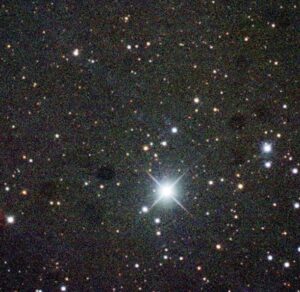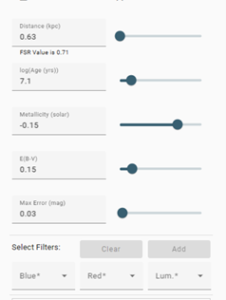IC 2395 is a young star cluster located in the Southern constellation Vela. This cluster was first discovered in 1908 by Solon Irving Baily. This cluster was also independently discovered later, which caused some discrepancy on whether or not IC 2395 and BH 47 are the same cluster, but both Claria´ et al. (2003) and Jorgensen & Westerlund (1988) agree that they are the same cluster.
I collected a total of 15 images using they Skynet telescope PROMPT-MO-1 in the B, V, and R filters, each making up 5 out of the 15 images. I then used Afterglow and Cluster Astromancer to estimate the age, metallicity, color, reddening, and brightness. I used these factors to fit isochrone models and to make a de-reddened color image. I found the distance to be 0.63 kpc, log(age(years)) to be 7.1, Metallicity to be -0.15, and reddening (E(B-V) to be 0.15


 I also found the proper motions of -4.41 and 3.27 for right ascension and declination. These values are very similar to the values found in the MWSC (Milky Way Star Clusters Catalog) Kharchenko et al (2013.) While my graphs seem to fit better on the bottom half of the distribution, the MWSC did a better job fitting the top half. The major difference is that the MWSC isochrone models did not include metallicity as the study was done before Gaia data, and the metallicity was assumed to be 0.
I also found the proper motions of -4.41 and 3.27 for right ascension and declination. These values are very similar to the values found in the MWSC (Milky Way Star Clusters Catalog) Kharchenko et al (2013.) While my graphs seem to fit better on the bottom half of the distribution, the MWSC did a better job fitting the top half. The major difference is that the MWSC isochrone models did not include metallicity as the study was done before Gaia data, and the metallicity was assumed to be 0.
In my color image there is clearly a much brighter object in the field, with a mag of about 5.5. Other than this, there was not much that was very remarkable in my findings, as my isochrone model was very typical and the image is not as dazzling as many other clusters full of nebulae and other fascinating objects. However, I think that the wide color distribution of stars from blue-white all the way to dull red-orange is charming in its own right, and these blue stragglers did show up on the isochrone model, but only at higher max error values and thus were left out of the final graph. This globular cluster does not have many stars, which caused a little bit of difficulty in analysis, but it was a fantastic learning experience. Working with my own images felt very rewarding, so much more than working on the same images dozens of others are doing.
Having completed my analysis, I am much more confident in my abilities with both Afterglow image processing and using isochrone models. This project was very enjoyable and fulfilling. It was very interesting learning about how astronomy can evolve over time with more and more access to new technology and information. Having looked through various isochrone models in the MWSC, I am also very impressed with the abilities of past astronomers making do with less information and still finding as good or better results than I was able to. I really could not have asked for more in a project like this. Everything from imaging to fitting the isochrone model went very smoothly, and I enjoyed the time I spent investigating this cluster.